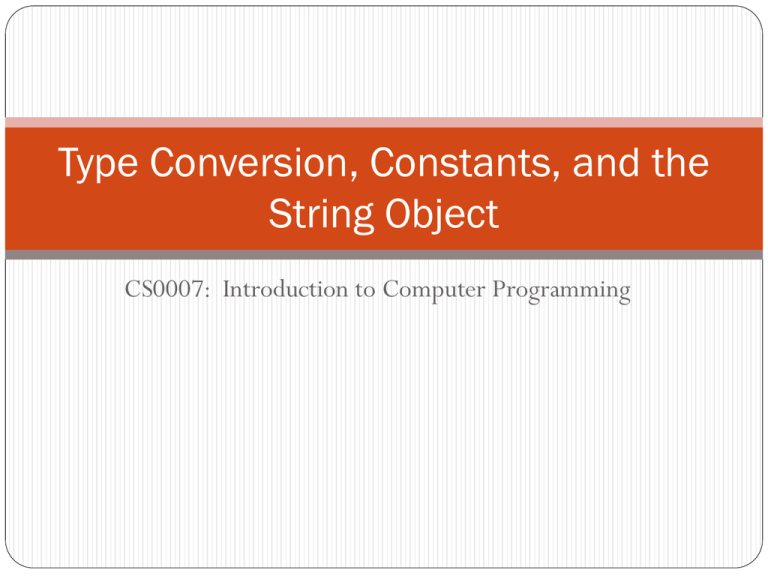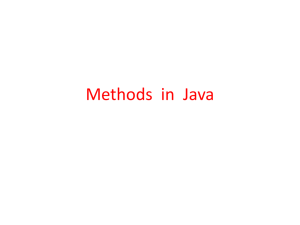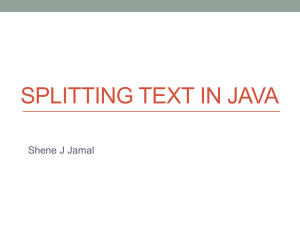Type Conversion, Named Constants, and the String Class
advertisement

Type Conversion, Constants, and the
String Object
CS0007: Introduction to Computer Programming
Review
Integer Data Types
byte
short
int
long
Floating-Point Data Types
float
double
String Concatenation is…
the process of appending to the end of a string.
String Concatenation Operator
+
Review
Entities of the boolean data type can have one of two values:
true
false
Entities of the char data type can take one what kind of values:
Single Characters
Characters are represented in memory as…
2 bytes integers
Character Literals are encapsulated in
Single Quotes (')
String Literals are encapsulated in
Double Quotes (")
Review
You can declare multiple variables on the same line by
separating them with a…
Comma (,)
You can assign a variable a value in the same line as you
declare it through a process called…
Initialization
Some Arithmetic Operators
+, -, *, /, %
You can do more complex mathematical operations like
square root and exponents with the Math class.
Combined Assignment Operators
Often you want to do a mathematical operation to the value in a variable and store the
result back into the same variable:
Computing the sum:
sum = sum + newNumber;
Counting
count = count + 1;
Doubling a number:
number = number * 2;
Many others
You can shorten these with combined assignment operators:
sum += newNumber;
count += 1;
number *= 2;
You can do this with any of the mathematical operators.
There is also an operator to add one to (increment) a variable :
++
Example: sum++;
Combined Assignment Operators
Example
New Topics:
Combined Assignment Operators
Increment Operator
Conversion Between Primitive Data
Types
Java is known as a strongly typed language.
In a Strongly Typed Language before a value is assigned to a variable, Java
checks the types of the variable and the value being assigned to it to
determine if they are compatible.
For example:
int x;
double y = 2.5;
x = y;
This will cause an error
int x;
short y;
x = y;
This will NOT cause an error
…but, why?
Conversion Between Primitive Data
Types
Types in Java have “ranks”.
Ranks here means that if a type has a higher rank than another, it
can hold more numbers, and thus, will not lose any precision.
Ranks (Highest to Lowest):
1. double
2. float
3. long
4. int
5. short
6. byte
Conversion Between Primitive Data
Types
In assignment statements where values of a lower-ranked data
types are stored in variables of higher-ranked data types, Java
automatically converts the lower-ranked value to the higherranked type.
This is called a Widening Conversion.
double x;
int y = 10;
x = y;
A Narrowing Conversion us a conversion of a value to a lower-ranked
type.
These can cause a loss of data, so Java does not automatically perform them.
Imagine converting from double to int…
You can perform narrowing conversions with type casting operators.
Type Cast Operators
Type Cast Operators allow you to manually convert from
one type to another, even if it is a narrowing conversion.
In Java they are unary operators that appear before what you
want to convert.
They are written as the type you want to convert to in
parentheses.
Example: x = (int)number;
If number is of a numeric data type, it will convert the value in number to
the int type and assigned to x.
If number is a floating-point type, the fractional part of the value would
be lost int type and assigned to x.
This is called truncation.
The value in number would not be changed.
Type Casting Example 1
New Topics:
Type Casting
Type Casting Side Effects
Type Conversion in Arithmetic
Operations
Recall integer division:
int number1 = 10, number2 = 4;
double number3 = number1 / number2;
number3 will have 2.0 stored in it as a result of the division because both
operands of the division are of type int.
We can use type casting on one of the operands to make sure the result is a
double:
int number1 = 10, number2 = 4;
double number3 = (double)number1 / number2;
number3 will have 2.5 stored in it as a result of the division because one of
the operands is of type double.
Note that type casting operators can be applied to expressions enclosed in
parentheses:
int number1 = 10, number2 = 4;
double number3 = (double)(number1 / number2);
number3 will have 2.0 stored in it as a result of the division because the type
casting operator is applied to the result of the integer division, which is 2.
Type Casting Example 2
New Topics:
Type cast operators in arithmetic expressions
Mixed Integer Operations
One of the nuances in Java is that when you use any integer type in
an arithmetic operation, it temporarily converts them to int.
This can cause problems:
short number1 = 10, number2 = 20, number3;
number3 = number1 + number2;
The second line will cause an error! Why?
Because the result of the addition of number1 and number 2 is of the int
type, which is over a higher rank than number3’s type, short.
Cannot make the narrowing conversion.
The way to fix this is to cast the entire expression to short:
short number1 = 10, number2 = 20, number3;
number3 = (short)(number1 + number2);
Other Mixed Mathematical Expressions
When Java sees that an expression has operands of double,
float, or long, it attempts to convert all the operands of
lower rank to that type.
For Example:
double number1 = 2.5, number3;
int number2 = 4;
number3 = number1 + number2;
Before the addition number2 is converted to type double,
and the result is a double.
Named Constants
Imagine you ran into this code:
amount = balance * 0.069;
What is 0.069?
An interest rate?
A fee of some sort?
Say it is an interest rate, maybe you need to use the rate
multiple times in a program.
What happens if the interest rate changes?
You need to change it everywhere it is used in the code…
How can we fix this?
Answer: Named constants.
Named Constants
A Named Constant is a variable whose value is read only and cannot be changed
during the program’s execution.
You can create a named constant, declare and initialize it just like any other
variable, but put the key word final in front of the data type:
final double INTEREST_RATE = 0.069;
By convention, programmers tend to make the names of named constants all
capital letters with underscores separating words in the name.
Now, instead of using a literal that is NOT self-documenting, you can use the
named constant:
amount = balance * INTEREST_RATE;
If the interest rate changes to 0.084, instead of having to find every
occurrence of 0.069 in the code, you can simply change the initialization
value:
final double INTEREST_RATE = 0.084;
The Java API provides some useful named constants:
Example: Math.PI
area = Math.PI * radius * radius;
Named Constants Example
New Topics:
Named Constants
The String Class
We’ve seen strings in the form of string literals:
"Hello World"
Even though they are very important, String is NOT a
primitive type in Java. The Java API provides a class called
String.
We’ve talked about classes before:
Programmers need to create a class that describes the methods
and attributes that make up objects created with the class.
Again, you can think of classes as being the blueprint that objects may be
created from.
In other words, a class is not an object but a description of one.
An object that is created from a class is called an instance of the class.
The String Class
To declare a string variable:
String variable;
When you use the String keyword to create a string variable, it is
actually creating a class type variable.
A Class Type Variable does not hold the actual value of the string, but the
memory address of the data item it is associated with.
This is represented differently in memory
int number = 25;
This stores the actual value of 25 in the variable.
String name = "Eric";
Since this is a class type variable, it holds the memory address of a String
object that holds the value "Eric".
It is said that the variable references the object, because it holds the memory
location, for this reason class type variables are known as reference variables.
The String Object
You can store a value in a String object much like you
would store a value into a variable of a primitive type.
String name;
name = "Eric";
The first line declares the String variable name.
The corresponding String object is not actually created until
the assignment statement on the second line.
Again, the variable name references the String object that
holds the value "Eric".
As seen before, you can also initialize a String variable.
String Variable Example 1
New Topics:
String Variables
String Methods
Because the String type is a class instead of a primitive
type, it has numerous methods for working with strings.
The general form for using the methods for a reference
variable is:
referenceVariableName.methodName(arguments…);
referenceVariableName – name of the reference
variable
methodName – name of the methods
arguments… – is zero or more arguments passed to the
method
String Methods
The length method returns the number of characters in the
string:
stringSize = name.length();
Here, the variable stringSize is assigned the number of characters in
the string referenced by name.
The name.length() portion is called a method call.
To call a method is to execute it.
The length method is said to return the number of characters as an int.
A method returns a value if it sends a value back to where it was called.
There are many methods in the String class. A few include:
charAt(index);
toLowerCase();
toUpperCase();
String Methods Examples
New Topics:
length() – returns the number of characters in the string
as an int
charAt(index) – index is an int value that specifies a
character position in the string that is to be returned. The first
character is at index 0. Return type is char.
toLowerCase() – returns a new string that is the
lowercase equivalent of the string.
toUpperCase() – returns a new string that is the
uppercase equivalent of the string.









